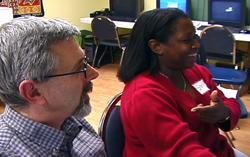![]()
Contact:
(JavaScript must be enabled to view this email address), Project Coordinator
![]()
- Sep. 10: YourHub.com users can benefit from new association
- Aug. 25: The Value of Rural News
- Jun. 19: CNNâs iReport Sees Iran Growth
In Wisconsin, Common Ground for Citizen Journalists
Madison Commons, Madison, Wisconsin
![]()
Sponsored by the University of Wisconsin-Madison School of Journalism & Mass Communications, in collaboration with neighborhood planning councils and non-profit groups
![]()

Project Director Lewis Friedland works on a neighborhood news story with Sheri Carter, a student in the South Side Community Journalism Workshop.
The Idea:
After studying the successes and failures of the civic journalism movement in the 1990s, UW-Madison journalism professor Lewis A. Friedland wanted to create a community-led news model that would encourage civic engagement and raise public awareness, without having to rely on the budgets or whims of the mainstream media.
“One thing it would take would be some sort of organization that would be larger than the sum of its media partners, where citizens had some very formal convening role, certainly, but also sustaining role and essentially a very large say over whether a project continued or not,” Friedland said.

Brian OâDonnell, a student in the East Side Community Journalism Workshop, works on his story in the computer lab.
The result was Madison Commons, an online news site that trains citizen journalists to report on their own neighborhoods.
The Training:
The six-week training course includes three classroom sessions, with the citizen recruits developing stories during the weeks that there is no formal class session.
Workshops focused on how to interview, research and take notes for stories, how to structure different types of news stories, ethical issues in reporting, and the importance of fairness and balance. In fall 2006, the course also included a session about writing blogs.

Students in the South Side Community Journalism Workshop cope with deadline pressure as they finish writing their stories.
“That structure helped people learn better, and more quickly,” Friedland said. “I think thatâs one thing I would strongly recommend to anyone trying to do this is that having a curriculum really does matter.”
Teaching lessons and class guidelines can be viewed here.
The Recruits:
Working with neighborhood planning councils, the program has advertised for participants through community newsletters, neighborhood listservs and word-of-mouth. The citizen recruits have included state workers, a cook, a librarian, and community activists.

Npib Thao, a high school sophomore and a student in the South Side Community Journalism Workshop, takes advice from project Managing Editor Chris Long.
The program has trained about 60 people, with five to 10 individuals continuing to contribute on a regular basis, according to program coordinator Cathy DeShano. Friedland said that even participants who were enthusiastic about the program found that they did not have the time to devote to developing fully reported community news stories.
“Citizen journalists found out that it wasnât just writing,” Friedland said. “Even the ones that kind of knew that learned first hand that the writing is the end result of a lot of hard work. Itâs not something fun that you sit down and just do because you have an idea. The work that went in was fairly demanding.”
The Results:
Finished articles are posted at MadisonCommons.org, which also highlights community news from other local media sources. DeShano said local media outlets, in turn, have published some of the work of the citizen journalists. Madison Commons stories have also appeared in The Wisconsin State Journal, The Capital Times, and Isthmusâ Daily Page.

Managing Editor Chris Long helps Rose Johnson-Brown, a student in the South Side Community Journalism Workshop.
Examples of stories produced by Madison Commons reporters:





Comments
Be the first to leave a comment on this page!